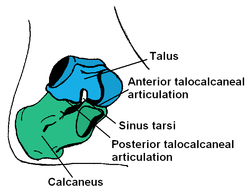Subtalar Joint Arthritis
Anatomy[edit | edit source]
The subtalar joint also named the talocalcaneal joint, is articulating between two tarsal bones the talus and calcaneus bones. There are three facets on each of the talus and calcaneus. The posterior talocalcaneal articulation represents the largest component of the subtalar joint.[1]The malalignment of the subtalar joint can lead to primary osteoarthritis of the ankle joint in the long run.
Function and Biomechanics of Subtalar joint[edit | edit source]
The Subtalar joint is necessary for:
- The function of the foot and the ankle and gait.[2]
- Transmission of rotations from the leg and the ankle to the foot.[3]
- Shock absorption during the early stance phase.[3]
The Subtalar joint movements are inversion-eversion[4] and supination-pronation (three-dimensional motions)[5]. Pronation combines dorsiflexion, abduction, and eversion, and supination combines plantarflexion, adduction, and inversion[6].
Main ligaments of Subtalar Joint[edit | edit source]
- Anterior talocalcaneal ligament
- Posterior talocalcaneal ligament
- Lateral talocalcaneal ligament
- Medial talocalcaneal ligament
Nonweight bearing Subtalar Joint Motion[edit | edit source]
In non-weight bearing positions, the movement is described as the motion of the distal segment which is the calcaneus. The calcaneus is moving on the relatively stationary talus and the lower leg. Supination is a combination of adduction, inversion and plantar flexion. Pronation is a combination of abduction, eversion, and dorsiflexion.
The most easily observed coupled motions of the calcaneus are inversion and eversion. During inversion, there is varus movement of the calcaneus and during eversion, there is the valgus movement of the calcaneus.
Weight-bearing Subtalar Motion[edit | edit source]
The movement is the same as in the non-weight bearing position but the description of which segment is moving is different. The motion of the proximal segment to the distal segment is described.
Risk Factors[edit | edit source]
- Subtalar Joint Dislocation[7].
- Subtalar joint instability.
- Malalignment of the joint.
- Rheumatoid arthritis.
- Fracture of calcaneus/talus.
- Supramalleolar deformities.[8]
Clinical Signs Of Osteoarthritis[edit | edit source]
- Coarse Crepitus.
- Bony Enlargement.
- Joint line tenderness.
- Reduced joint range of motion.[9]
Treatment[edit | edit source]
Diseases such as arthritis can influence the Ankle range of motion[10], so it is important to do Subtalar ROM exercises (inversion-eversion and supination-pronation).
Physiotherapy Management[edit | edit source]
Maitland Mobilisation of Subtalar Joint[edit | edit source]
Subtalar joint distraction
Subtalar joint medial glide & lateral glide
References[edit | edit source]
- ↑ Ficke J, Byerly DW. Anatomy, Bony Pelvis and Lower Limb, Foot. InStatPearls [Internet] 2021 Aug 11. StatPearls Publishing. Accessed 7 June 2022.
- ↑ Jastifer JR, Gustafson PA. The subtalar joint: biomechanics and functional representations in the literature. The foot. 2014 Dec 1;24(4):203-9. Accessed 15 June 2022.
- ↑ 3.0 3.1 Stagni R, Leardini A, O'Connor JJ, Giannini S. Role of passive structures in the mobility and stability of the human subtalar joint: a literature review. Foot & ankle international. 2003 May;24(5):402-9. Accessed 15 June 2022.
- ↑ Krähenbühl N, Horn-Lang T, Hintermann B, Knupp M. The subtalar joint: a complex mechanism. EFORT open reviews. 2017 Jul 6;2(7):309-16. Accessed 15 June 2022.
- ↑ Brockett CL, Chapman GJ. Biomechanics of the ankle. Orthopaedics and trauma. 2016 Jun 1;30(3):232-8. Accessed 15 June 2022.
- ↑ Peña Fernández M, Hoxha D, Chan O, Mordecai S, Blunn GW, Tozzi G, Goldberg A. Centre of rotation of the human subtalar joint using weight-bearing clinical computed tomography. Scientific reports. 2020 Jan 23;10(1):1-4. Accessed 15 June 2022.
- ↑ Flippin M, Fallat LM. Open talar neck fracture with medial subtalar joint dislocation: a case report. The Journal of Foot and Ankle Surgery. 2019 Mar 1;58(2):392-7. Accessed 28, June 2022.
- ↑ Kanemitsu M, Nakasa T, Ikuta Y, Ota Y, Sumii J, Nekomoto A, Sakurai S, Adachi N. Characteristic Bone Morphology Change of the Subtalar Joint in Severe Varus Ankle Osteoarthritis. The Journal of Foot and Ankle Surgery. 2022 May 1;61(3):627-32. Accessed 31, August 2022.
- ↑ Abhishek A, Doherty M. Diagnosis and clinical presentation of osteoarthritis. Rheumatic Disease Clinics. 2013 Feb 1;39(1):45-66.
- ↑ Brockett CL, Chapman GJ. Biomechanics of the ankle. Orthopaedics and trauma. 2016 Jun 1;30(3):232-8. Accessed 31 August 2022.
- ↑ Subtalar Joint | Passive Range of Motion. Available from: https://www.youtube.com/watch?v=GJCWxx_3oiE [last accessed 31/8/2022]







